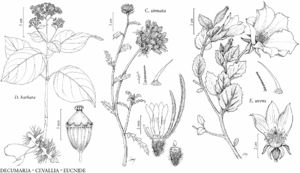Decumaria
Sp. Pl. ed. 2, 2: 1663. 1763.
| Taxon | Illustrator ⠉ | |
|---|---|---|
 | Eucnide urens Cevallia sinuata Decumaria barbara | Linny Heagy Linny Heagy Yevonn Wilson-Ramsey |
Woody vines. Stems climbing, sometimes trailing and forming loose nonflowering mats. Bark exfoliating in grayish or reddish-brown sheets, strips, or strings. Branches spreading laterally or declining; twigs glabrous or with simple trichomes. Leaves deciduous or semideciduous, opposite; petiole present; blade ovate, elliptic, obovate, oblanceolate, subround, or round, herbaceous, margins usually entire, rarely dentate or lobed, plane; venation pinnate. Inflorescences terminal, on shoots of the season, corymbs, (20–) 50–100-flowered; peduncle present. Pedicels present. Flowers bisexual; perianth and androecium epigynous; hypanthium completely adnate to ovary, turbinate, strongly 7–12-ribbed in fruit; sepals persistent, 7–12, erect, triangular, glabrous; petals 7–12, valvate, spreading, white, lanceolate, elliptic, or oblong, base essentially sessile, surfaces glabrous; stamens 20–30; filaments distinct, dorsiventrally flattened, linear, tapering abruptly just proximal to apex, apex not 2-lobed; anthers suborbiculate to ovate; pistil 6–12-carpellate, ovary completely inferior, 6–12-locular; placentation axile proximally, parietal distally; style persistent, 1. Capsules turbinate, cartilaginous, dehiscence intercostal, lateral walls separating from ribs, eventually leaving cagelike remnants. Seeds 10–20 per locule, yellow, fusiform. x = 14.
Distribution
se United States, Asia (China)
Discussion
Species 2 (1 in the flora).
A molecular phylogenetic study of tribe Hydrangeeae (Y. De Smet et al. 2015) found Hydrangea to be polyphyletic. The authors promoted adoption of a broader, monophyletic concept of Hydrangea that includes all eight genera in the tribe, including Decumaria. Decumaria is treated here in its traditional sense.
Selected References
None.
Lower Taxa
"connate" is not a number. "distinct" is not a number.